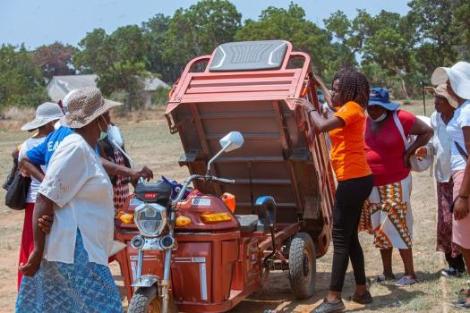Mobility for Africa : Promoting access to sustainable, electric mobility in rural areas to empower women
2022
Association Climate Chance (Climate Chance)
In Africa, around 450 million people (more than 70% of the rural population) are not served because of a lack of infrastructure and transport systems. In Zimbabwe, the lack of transport infrastructure has a significant impact on the agricultural sector, which provides a livelihood for around 70% of the population and 15-20% of the country’s GDP. It provides jobs, contributes to economic growth, poverty reduction and food and nutritional security. There are an estimated 18,000 new farmers working under contract or sub-contracted partnerships in Zimbabwe. These small-scale farmers travel long distances on foot or by motorbike to reach their farms. To remedy this situation, the local start-up Mobility for Africa has been developing an integrated, safe and replicable electric micro-mobility system for the rural populations of Wedza, Domboshawa and Chipinge since 2019, with the aim of improving their mobility and working conditions in the long term and helping to reduce pollution.
To download : bs2022_fr_transport_ce_mobility-for-africa.pdf (170 KiB)

Improving the quality of life of rural populations with « Hambas
Against a backdrop of changing mobility patterns and the emergence of new modes of transport in Africa, Mobility for Africa has been providing a shared electric mobility service since 2019 based on « Hambas », geolocatable tricycles powered by a standardised solar-powered battery swap system. Unlike a battery recharging system, which can take several hours, the swap system enables a discharged battery to be replaced by a charged one in just a few minutes. Mobility for Africa rents the tricycles to groups of women (maximum 5) for $15 a month. These women can then transport and sell their agricultural produce to more distant markets. As well as meeting MDGs 1, 5, 7, 10 and 17, this integrated service opens up growth opportunities for the beneficiaries in the rural communities of Chipinge, Domboshawa and Wedza by significantly increasing their income. According to 60 Decibels, an independent impact measurement company, the transport and logistics service, these Hambas, enable 92% of beneficiaries to improve their safety when travelling. They also make it easier to transport people to health facilities, particularly pregnant women. 87% reported a net reduction in journey time, and 99% saw their self-confidence increase.
Electric tricycles for « cleaner » mobility
Adopting a form of community micromobility such as the electric tricycle is one way of achieving « cleaner », safer and more accessible mobility, independent of fossil fuels, which are responsible for 33% of the country’s greenhouse gas emissions. The solution put in place by Mobility for Africa includes training for beneficiaries and employees in driving and operating the tricycle and battery technology. A Research and Development (R&D) programme has also been deployed within the community to monitor and continually test the adaptability and safety of the tricycle, as well as the battery management system, the GPS system, fleet management and the collection of new data.
An initiative that is spreading across the state
In 2020, in partnership with PManifold, a research and consultancy company specialising in energy, e-mobility and the environment, Mobility for Africa supported the Zimbabwean government in drawing up its framework law and roadmap for the adoption of electric mobility. The process was initiated by the Ministry of Environment and Tourism and the Ministry of Energy and Power, with funding from the Climate Technology Centre and Network (CTCN) and the Digital Transformation section of the United Nations Environment Programme (UNEP). In Zimbabwe, as in many other countries in the region, the classification of vehicles is obsolete and managed by a multitude of entities, which hinders the transition to electric mobility. The draft law and targets are due to be adopted in 2022 and could accelerate the action and investment needed to make this transition a reality.